微观经济学参考教学教材
- 格式:doc
- 大小:150.00 KB
- 文档页数:6
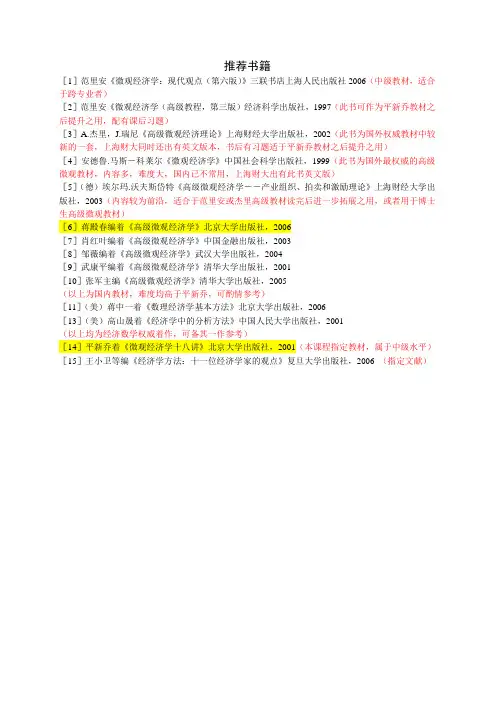
推荐书籍
[1]范里安《微观经济学:现代观点(第六版)》三联书店上海人民出版社2006(中级教材,适合于跨专业者)
[2]范里安《微观经济学(高级教程,第三版)经济科学出版社,1997(此书可作为平新乔教材之后提升之用,配有课后习题)
[3]A.杰里,J.瑞尼《高级微观经济理论》上海财经大学出版社,2002(此书为国外权威教材中较新的一套,上海财大同时还出有英文版本,书后有习题适于平新乔教材之后提升之用)
[4]安德鲁.马斯-科莱尔《微观经济学》中国社会科学出版社,1999(此书为国外最权威的高级微观教材,内容多,难度大,国内已不常用,上海财大出有此书英文版)
[5](德)埃尔玛.沃夫斯岱特《高级微观经济学--产业组织、拍卖和激励理论》上海财经大学出版社,2003(内容较为前沿,适合于范里安或杰里高级教材读完后进一步拓展之用,或者用于博士生高级微观教材)
[6]蒋殿春编着《高级微观经济学》北京大学出版社,2006
[7]肖红叶编着《高级微观经济学》中国金融出版社,2003
[8]邹薇编着《高级微观经济学》武汉大学出版社,2004
[9]武康平编着《高级微观经济学》清华大学出版社,2001
[10]张军主编《高级微观经济学》清华大学出版社,2005
(以上为国内教材,难度均高于平新乔,可酌情参考)
[11](美)蒋中一着《数理经济学基本方法》北京大学出版社,2006
[13](美)高山晟着《经济学中的分析方法》中国人民大学出版社,2001
(以上均为经济数学权威着作,可备其一作参考)
[14]平新乔着《微观经济学十八讲》北京大学出版社,2001(本课程指定教材,属于中级水平)[15]王小卫等编《经济学方法:十一位经济学家的观点》复旦大学出版社,2006 (指定文献)。
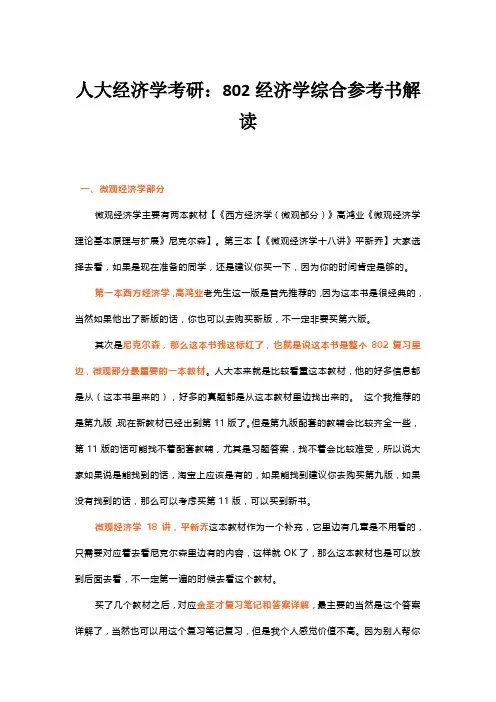
人大经济学考研:802经济学综合参考书解读一、微观经济学部分微观经济学主要有两本教材【《西方经济学(微观部分)》高鸿业《微观经济学理论基本原理与扩展》尼克尔森】。
第三本【《微观经济学十八讲》平新乔】大家选择去看,如果是现在准备的同学,还是建议你买一下,因为你的时间肯定是够的。
第一本西方经济学,高鸿业老先生这一版是首先推荐的,因为这本书是很经典的,当然如果他出了新版的话,你也可以去购买新版,不一定非要买第六版。
其次是尼克尔森,那么这本书我这标红了,也就是说这本书是整个802复习里边,微观部分最重要的一本教材。
人大本来就是比较看重这本教材,他的好多信息都是从(这本书里来的),好多的真题都是从这本教材里边找出来的。
这个我推荐的是第九版,现在新教材已经出到第11版了。
但是第九版配套的教辅会比较齐全一些,第11版的话可能找不着配套教辅,尤其是习题答案,找不着会比较难受,所以说大家如果说是能找到的话,淘宝上应该是有的,如果能找到建议你去购买第九版,如果没有找到的话,那么可以考虑买第11版,可以买到新书。
微观经济学18讲,平新乔这本教材作为一个补充,它里边有几章是不用看的,只需要对应着去看尼克尔森里边有的内容,这样就OK了,那么这本教材也是可以放到后面去看,不一定第一遍的时候去看这个教材。
买了几个教材之后,对应金圣才复习笔记和答案详解,最主要的当然是这个答案详解了,当然也可以用这个复习笔记复习,但是我个人感觉价值不高。
因为别人帮你总结的东西没有自己总结的好,也没有自己总结的印象深刻,所以我当时主要还是把它当一本答案书来看。
二、宏观经济学部分宏观经济学,高鸿业老先生这本书还是拿来这个入门的。
其次可以用曼昆的那一本经济学原理。
微观无论是用高鸿业的,还是用曼昆的都行。
宏观的话,建议还是一定要看一下高鸿业老先生这本,因为它里边关于流派一些的总结是曼昆的教材里边没有的,所以说这本教材是必然要看的。
而且它作为入门看着比较轻松。
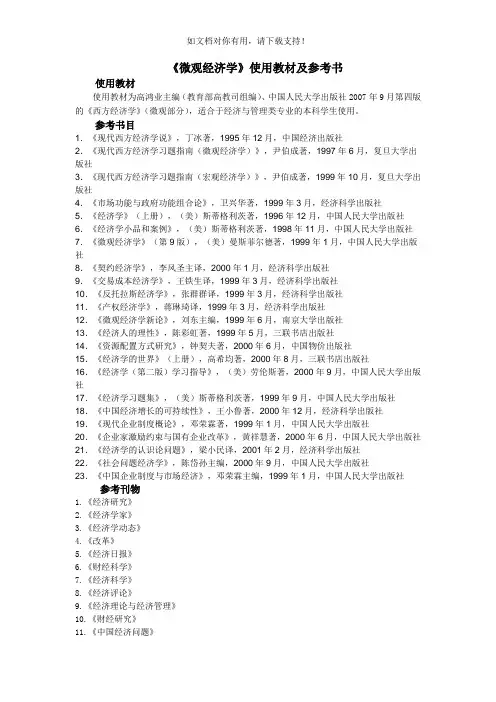
《微观经济学》使用教材及参考书使用教材使用教材为高鸿业主编(教育部高教司组编)、中国人民大学出版社2007年9月第四版的《西方经济学》(微观部分),适合于经济与管理类专业的本科学生使用。
参考书目1.《现代西方经济学说》,丁冰著,1995年12月,中国经济出版社2.《现代西方经济学习题指南(微观经济学)》,尹伯成著,1997年6月,复旦大学出版社3.《现代西方经济学习题指南(宏观经济学)》,尹伯成著,1999年10月,复旦大学出版社4.《市场功能与政府功能组合论》,卫兴华著,1999年3月,经济科学出版社5.《经济学》(上册),(美)斯蒂格利茨著,1996年12月,中国人民大学出版社6.《经济学小品和案例》,(美)斯蒂格利茨著,1998年11月,中国人民大学出版社7.《微观经济学》(第9版),(美)曼斯菲尔德著,1999年1月,中国人民大学出版社8.《契约经济学》,李风圣主译,2000年1月,经济科学出版社9.《交易成本经济学》,王铁生译,1999年3月,经济科学出版社10.《反托拉斯经济学》,张群群译,1999年3月,经济科学出版社11.《产权经济学》,蒋琳琦译,1999年3月,经济科学出版社12.《微观经济学新论》,刘东主编,1999年6月,南京大学出版社13.《经济人的理性》,陈彩虹著,1999年5月,三联书店出版社14.《资源配置方式研究》,钟契夫著,2000年6月,中国物价出版社15.《经济学的世界》(上册),高希均著,2000年8月,三联书店出版社16.《经济学(第二版)学习指导》,(美)劳伦斯著,2000年9月,中国人民大学出版社17.《经济学习题集》,(美)斯蒂格利茨著,1999年9月,中国人民大学出版社18.《中国经济增长的可持续性》,王小鲁著,2000年12月,经济科学出版社19.《现代企业制度概论》,邓荣霖著,1999年1月,中国人民大学出版社20.《企业家激励约束与国有企业改革》,黄祥慧著,2000年6月,中国人民大学出版社21.《经济学的认识论问题》,梁小民译,2001年2月,经济科学出版社22.《社会问题经济学》,陈岱孙主编,2000年9月,中国人民大学出版社23.《中国企业制度与市场经济》,邓荣霖主编,1999年1月,中国人民大学出版社参考刊物1.《经济研究》2.《经济学家》3.《经济学动态》4.《改革》5.《经济日报》6.《财经科学》7.《经济科学》8.《经济评论》9.《经济理论与经济管理》10.《财经研究》11.《中国经济问题》12.《宏观经济》13.《财经问题研究》14.《当代经济科学》15.《当代财经》主要网站1、经济学阶梯教室2、人大经济论坛3、经济政策研究中心4、经济学家 .cn/5、北京大学国际经济研究中心 .cn/cn/6、中国经济学教育科研网 .cn/cn/。
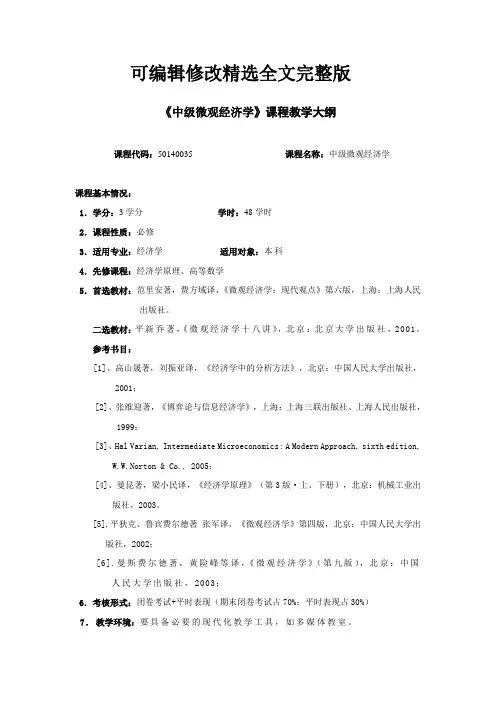
可编辑修改精选全文完整版《中级微观经济学》课程教学大纲课程代码:50140035课程名称:中级微观经济学课程基本情况:1.学分:3学分学时:48学时2.课程性质:必修3.适用专业:经济学适用对象:本科4.先修课程:经济学原理、高等数学5.首选教材:范里安著,费方域译,《微观经济学:现代观点》第六版,上海:上海人民出版社。
二选教材:平新乔著,《微观经济学十八讲》,北京:北京大学出版社,2001。
参考书目:[1]、高山晟著,刘振亚译,《经济学中的分析方法》,北京:中国人民大学出版社,2001;[2]、张维迎著,《博弈论与信息经济学》,上海:上海三联出版社、上海人民出版社,1999;[3]、Hal Varian, Intermediate Microeconomics: A Modern Approach, sixth edition,W.W.Norton & Co., 2005;[4]、曼昆著,梁小民译,《经济学原理》(第3版·上、下册),北京:机械工业出版社,2003。
[5].平狄克、鲁宾费尔德著张军译,《微观经济学》第四版,北京:中国人民大学出版社,2002;[6].曼斯费尔德著,黄险峰等译,《微观经济学》(第九版),北京:中国人民大学出版社,2003;6.考核形式:闭卷考试+平时表现(期末闭卷考试占70%;平时表现占30%)7.教学环境:要具备必要的现代化教学工具,如多媒体教室。
课程教学目的及要求:微观经济学是学习和掌握现代主流经济学的基础课程,是迈进经济学殿堂的重要阶梯。
现代经济学已经发展出一整套可经证伪的理论体系,与其他社会科学相比,它更趋近于自然科学,因而是一门更为“科学”的社会科学。
本课程旨在讲述两百年来经济学关于资源配置的解释性逻辑框架,演绎新古典经济学的理论架构,培养学生经济学的思维方式,使得他们能够像经济学家那样去思考现实中的各类经济问题。
学生通过学习,一方面需要把握微观经济理论的框架体系,弄清微观经济理论的基本内容,掌握其分析方法,了解其最新发展;另一方面,也是极为重要的,需要学会如何用所学到的理论分析工具,解释和分析现实中的经济问题。
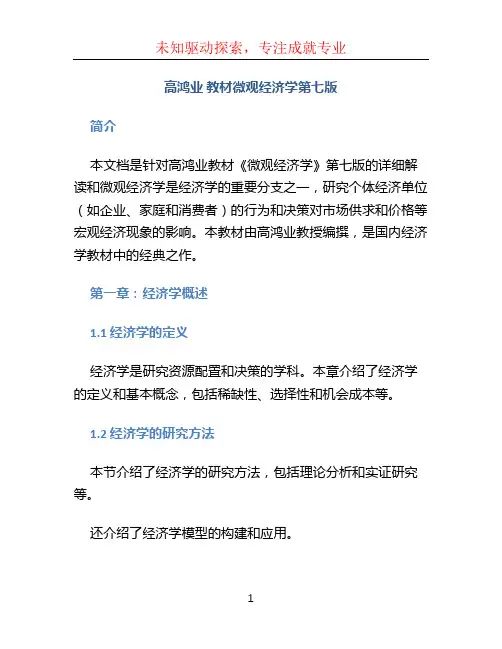
高鸿业教材微观经济学第七版简介本文档是针对高鸿业教材《微观经济学》第七版的详细解读和微观经济学是经济学的重要分支之一,研究个体经济单位(如企业、家庭和消费者)的行为和决策对市场供求和价格等宏观经济现象的影响。
本教材由高鸿业教授编撰,是国内经济学教材中的经典之作。
第一章:经济学概述1.1 经济学的定义经济学是研究资源配置和决策的学科。
本章介绍了经济学的定义和基本概念,包括稀缺性、选择性和机会成本等。
1.2 经济学的研究方法本节介绍了经济学的研究方法,包括理论分析和实证研究等。
还介绍了经济学模型的构建和应用。
1.3 经济学的应用领域本节介绍了经济学的应用领域,包括微观经济学、宏观经济学、产业经济学等。
第二章:供给和需求2.1 市场和市场机制本章介绍了市场和市场机制的基本概念,包括市场的定义、市场的参与者和市场交易等。
2.2 供给和需求的基本概念本节介绍了供给和需求的基本概念,包括供给的定义、需求的定义和市场均衡等。
2.3 市场调节机制本节介绍了市场调节机制的作用和影响,包括供求关系的改变和价格的调整等。
第三章:市场与政府3.1 政府的宏观调控本章介绍了政府的宏观调控措施,包括货币政策和财政政策等。
3.2 政府的微观调控本节介绍了政府的微观调控措施,包括价格管制和垄断的监管等。
3.3 市场失灵与政府干预本节介绍了市场失灵的原因和影响,以及政府干预的作用和局限性。
第四章:企业行为4.1 企业的目标和约束本章介绍了企业的目标和约束,包括利润最大化和成本最小化等。
4.2 企业的市场决策本节介绍了企业在市场中的决策行为,包括定价策略和生产策略等。
4.3 企业的组织与市场结构本节介绍了企业的组织形式和市场结构,包括竞争市场和垄断市场等。
第五章:市场结构和竞争5.1 市场结构的分类本章介绍了市场结构的分类方法,包括完全竞争市场和垄断市场等。
5.2 完全竞争市场的特征本节介绍了完全竞争市场的特征,包括无差异化产品和自由进出等。
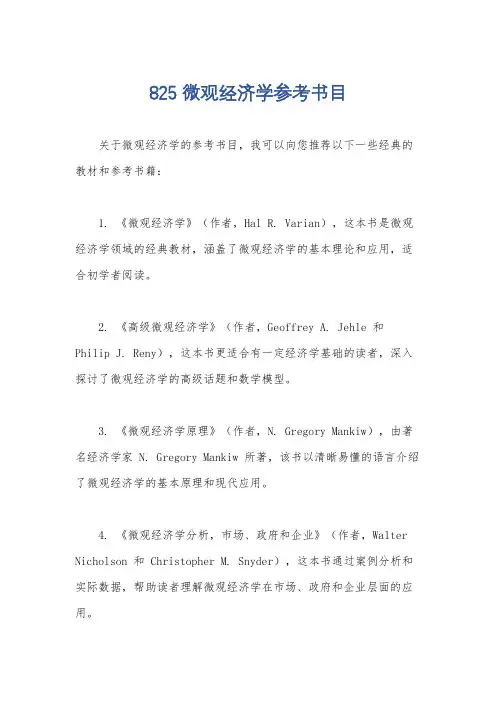
825微观经济学参考书目
关于微观经济学的参考书目,我可以向您推荐以下一些经典的教材和参考书籍:
1. 《微观经济学》(作者,Hal R. Varian),这本书是微观经济学领域的经典教材,涵盖了微观经济学的基本理论和应用,适合初学者阅读。
2. 《高级微观经济学》(作者,Geoffrey A. Jehle 和
Philip J. Reny),这本书更适合有一定经济学基础的读者,深入探讨了微观经济学的高级话题和数学模型。
3. 《微观经济学原理》(作者,N. Gregory Mankiw),由著名经济学家 N. Gregory Mankiw 所著,该书以清晰易懂的语言介绍了微观经济学的基本原理和现代应用。
4. 《微观经济学分析,市场、政府和企业》(作者,Walter Nicholson 和 Christopher M. Snyder),这本书通过案例分析和实际数据,帮助读者理解微观经济学在市场、政府和企业层面的应用。
以上书目涵盖了微观经济学的基础知识和高级话题,适合不同水平和需求的读者参考。
希望能够对您有所帮助。
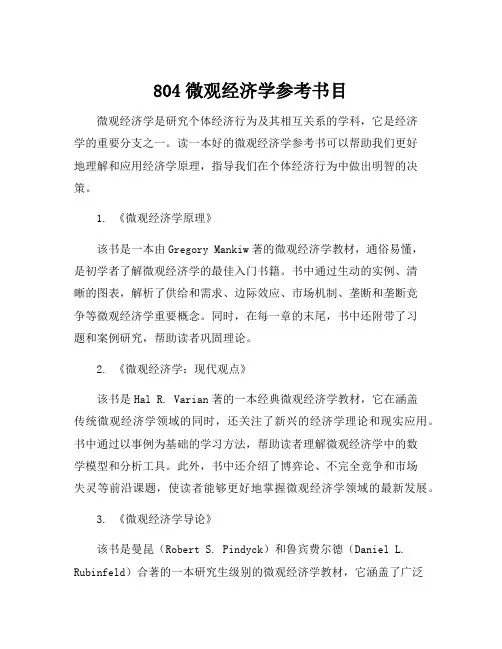
804微观经济学参考书目微观经济学是研究个体经济行为及其相互关系的学科,它是经济学的重要分支之一。
读一本好的微观经济学参考书可以帮助我们更好地理解和应用经济学原理,指导我们在个体经济行为中做出明智的决策。
1. 《微观经济学原理》该书是一本由Gregory Mankiw著的微观经济学教材,通俗易懂,是初学者了解微观经济学的最佳入门书籍。
书中通过生动的实例、清晰的图表,解析了供给和需求、边际效应、市场机制、垄断和垄断竞争等微观经济学重要概念。
同时,在每一章的末尾,书中还附带了习题和案例研究,帮助读者巩固理论。
2. 《微观经济学:现代观点》该书是Hal R. Varian著的一本经典微观经济学教材,它在涵盖传统微观经济学领域的同时,还关注了新兴的经济学理论和现实应用。
书中通过以事例为基础的学习方法,帮助读者理解微观经济学中的数学模型和分析工具。
此外,书中还介绍了博弈论、不完全竞争和市场失灵等前沿课题,使读者能够更好地掌握微观经济学领域的最新发展。
3. 《微观经济学导论》该书是曼昆(Robert S. Pindyck)和鲁宾费尔德(Daniel L. Rubinfeld)合著的一本研究生级别的微观经济学教材,它涵盖了广泛的微观经济学理论和应用领域。
书中系统地介绍了经济学家面临的决策问题,包括市场均衡、消费者与生产者理论、成本与供给、市场结构和经济效率等。
此外,书中还强调了实证研究和政策应用,并提供了大量的案例和数据分析,有助于读者将理论与实际相结合。
4. 《微观经济学:现代方法与实践》该书是Jeffrey M. Perloff著的一本引人入胜的微观经济学教材,它采用了现代方法和实践,深入剖析了经济学原则和市场机制。
书中通过丰富的实例和案例,帮助读者理解微观经济学中的复杂概念和理论模型。
此外,书中还涵盖了信息经济学、公共政策和行为经济学等前沿领域,使读者能够更加全面地了解和应用微观经济学。
综上所述,选择一本合适的微观经济学参考书对于我们深入理解经济学原理和指导个体决策至关重要。
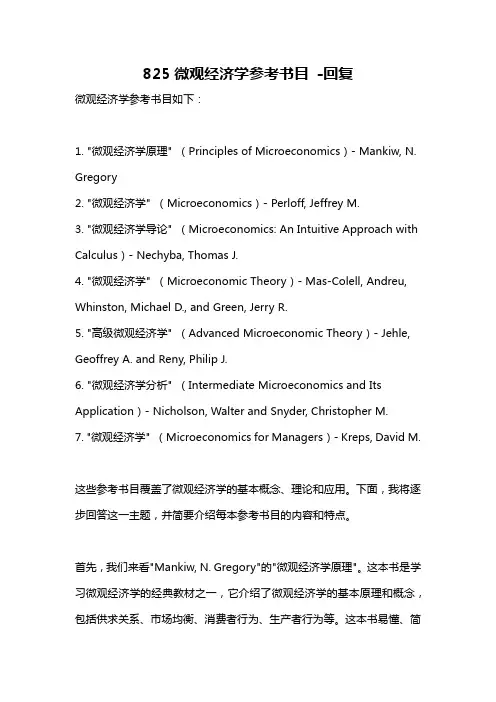
825微观经济学参考书目-回复微观经济学参考书目如下:1. "微观经济学原理" (Principles of Microeconomics)- Mankiw, N. Gregory2. "微观经济学" (Microeconomics)- Perloff, Jeffrey M.3. "微观经济学导论" (Microeconomics: An Intuitive Approach with Calculus)- Nechyba, Thomas J.4. "微观经济学" (Microeconomic Theory)- Mas-Colell, Andreu, Whinston, Michael D., and Green, Jerry R.5. "高级微观经济学" (Advanced Microeconomic Theory)- Jehle, Geoffrey A. and Reny, Philip J.6. "微观经济学分析" (Intermediate Microeconomics and Its Application)- Nicholson, Walter and Snyder, Christopher M.7. "微观经济学" (Microeconomics for Managers)- Kreps, David M.这些参考书目覆盖了微观经济学的基本概念、理论和应用。
下面,我将逐步回答这一主题,并简要介绍每本参考书目的内容和特点。
首先,我们来看"Mankiw, N. Gregory"的"微观经济学原理"。
这本书是学习微观经济学的经典教材之一,它介绍了微观经济学的基本原理和概念,包括供求关系、市场均衡、消费者行为、生产者行为等。
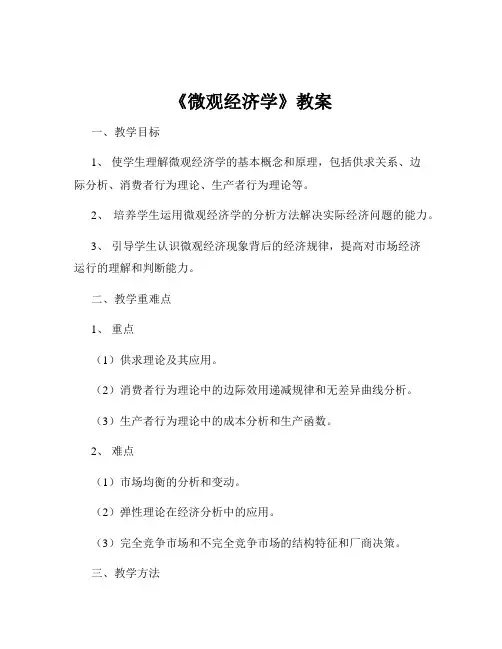
《微观经济学》教案一、教学目标1、使学生理解微观经济学的基本概念和原理,包括供求关系、边际分析、消费者行为理论、生产者行为理论等。
2、培养学生运用微观经济学的分析方法解决实际经济问题的能力。
3、引导学生认识微观经济现象背后的经济规律,提高对市场经济运行的理解和判断能力。
二、教学重难点1、重点(1)供求理论及其应用。
(2)消费者行为理论中的边际效用递减规律和无差异曲线分析。
(3)生产者行为理论中的成本分析和生产函数。
2、难点(1)市场均衡的分析和变动。
(2)弹性理论在经济分析中的应用。
(3)完全竞争市场和不完全竞争市场的结构特征和厂商决策。
三、教学方法1、讲授法:系统地讲解微观经济学的基本概念、原理和理论框架。
2、案例分析法:通过实际经济案例,引导学生运用所学知识进行分析和解决问题。
3、小组讨论法:组织学生分组讨论相关经济问题,促进学生之间的思想交流和合作学习。
四、教学过程1、课程导入(约 15 分钟)通过一个日常生活中的经济现象,如某种商品价格的波动,引出微观经济学的研究对象和重要性。
提问学生对这种价格波动的看法和原因猜测,激发学生的学习兴趣和思考。
2、供求理论(约 45 分钟)(1)讲解需求的概念、影响需求的因素(如价格、收入、偏好等),并通过图表展示需求曲线。
(2)讲解供给的概念、影响供给的因素(如成本、技术、预期等),展示供给曲线。
(3)分析供求的相互作用,讲解市场均衡的形成和变动,以及均衡价格和均衡数量的决定。
(4)通过实际案例,如农产品市场的供求变化,让学生理解供求理论的应用。
3、消费者行为理论(约 60 分钟)(1)介绍效用的概念和边际效用递减规律,通过实例让学生理解消费者在消费过程中的心理变化。
(2)讲解无差异曲线和预算线,分析消费者如何在有限的预算下实现效用最大化。
(3)通过实际消费选择的案例,让学生运用消费者行为理论进行分析和决策。
4、生产者行为理论(约 60 分钟)(1)讲解生产函数的概念和形式,分析短期生产和长期生产中的要素投入与产出关系。
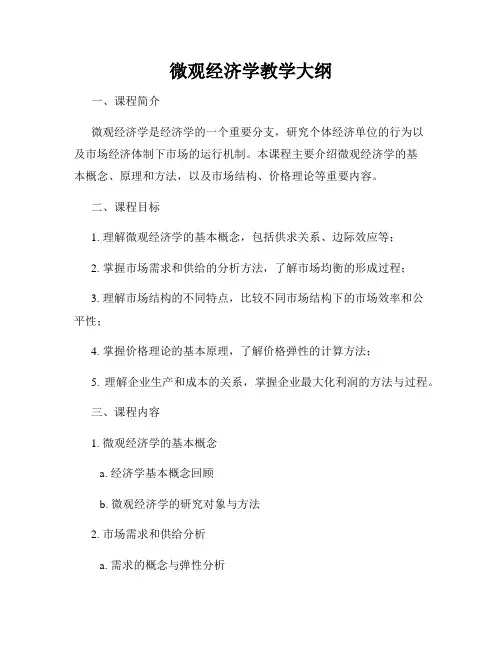
微观经济学教学大纲一、课程简介微观经济学是经济学的一个重要分支,研究个体经济单位的行为以及市场经济体制下市场的运行机制。
本课程主要介绍微观经济学的基本概念、原理和方法,以及市场结构、价格理论等重要内容。
二、课程目标1. 理解微观经济学的基本概念,包括供求关系、边际效应等;2. 掌握市场需求和供给的分析方法,了解市场均衡的形成过程;3. 理解市场结构的不同特点,比较不同市场结构下的市场效率和公平性;4. 掌握价格理论的基本原理,了解价格弹性的计算方法;5. 理解企业生产和成本的关系,掌握企业最大化利润的方法与过程。
三、课程内容1. 微观经济学的基本概念a. 经济学基本概念回顾b. 微观经济学的研究对象与方法2. 市场需求和供给分析a. 需求的概念与弹性分析b. 供给的概念与弹性分析c. 市场需求和供给的均衡分析3. 市场结构与市场效率a. 完全竞争市场结构b. 垄断市场结构c. 垄断竞争市场结构d. 集中度和市场效率的关系4. 价格理论与价格弹性a. 成本和供给决定价格b. 需求弹性的概念与计算c. 价格弹性的实际应用5. 企业生产和成本a. 企业生产函数和长期短期成本曲线b. 边际分析与企业供应决策c. 企业最大化利润的方法与过程四、教学方法1. 理论讲授:系统性地讲解微观经济学的基本概念、原理和方法。
2. 实例分析:通过实际案例,深入分析市场行为、企业决策等微观经济学的实际应用。
3. 讨论互动:组织学生进行小组讨论和案例分析,激发学生的思维和参与度。
4. 课堂练习:布置问题,引导学生独立思考和解决问题,巩固学习效果。
5. 资源导向:引导学生主动搜索并利用互联网等资源,提高信息获取和处理能力。
五、评价与考核1. 平时表现:包括课堂参与、课后作业完成情况等。
2. 期中考试:考察学生对微观经济学基本概念和原理的理解能力。
3. 期末考试:考察学生对市场结构、价格理论和企业决策等知识的综合应用能力。
4. 课程论文:要求学生选择一个与微观经济学相关的话题,进行深入研究和论述。

关于教材教材按书上运用数学的多少大致可以分为初级、中级和高级教程,初级:马歇尔的《经济学原理》,萨缪尔森的《经济学》(比较老的入门教材)曼昆的《经济学原理》,帕金的《微观经济学原理》,罗伯特弗兰克、本·伯南克联合写的《微观经济学原理》。
中高级教材:1、国内编著的平新桥的《微观经济学十八讲》。
2、平狄克《微观经济学》。
人大版,此书乃标准中级微观经济学教材。
在美国多个大学供mba采用,国内英文版有清华版,中文版有人大版。
此书内容适中,主题广泛,均是各部分理论之要点,不旁及其他分歧内容,其中定价部分较为详细。
图形清晰,语言流畅。
所采用数学工具甚浅,有函数但不涉及微分,只用差值。
曲线只用标准严格凹性曲线,不及拟凹部分、线性仿射内容,成本函数也均为线性。
建议此书应通读,可作进阶之用。
3、《微观经济学: 现代观点》范里安著,。
据美国W.W.诺顿图书公司2009年版译出,三联版。
此书是极规范之经济学专业的中级微观教材。
美国MIT,哈佛、伯克利经济学本科指定教材。
本书为第七版,内容除论述了市场、消费者偏好、需求、技术、利润、生产等问题,还增加了两章, 分别论述了要素供给和信息经济等。
内容上相当关注技术细节问题,比平狄克要更深一些。
范里安微观经济学与数学造诣极深。
然此书乃其为学生所写之中级教材,刻意避免数学之应用,大部分数学推导放于附录,微分运用相当少,适宜学完平狄克后重点阅读。
可作平狄克中各部分理论内容之拓展。
高级:1、张定胜《高级微观经济学》。
武大出版。
此书属于中高级内容,因涉及主题较少,故比平新乔之〈18讲〉显得清晰。
适宜找不到其他中高级教材,而高级教材又甚困难,可以此书做过渡。
2、范里安《高级微观经济学》经济管理出版社。
这是范里安在《微观经济学---现代观点》的基础上的标准高级教材。
每一章均相当简短但精要。
阅读时需要对中级教材有比较深入的学习。
但翻译质量不佳。
建议直接读英文版。
接近研究生一年级水平。
《中级微观经济学》参考书目
一、教材参考书目
1、平新乔,《微观经济学十八讲》,北京大学出版社
2、范里安,《微观经济学:现代观点》,上海三联出版社
二、其他参考书目
1、詹姆斯·M·亨德森,里查德·E·匡特,《中级微观经济理论——数学方法》,北京大学出版社,1989年版
2、萨缪尔森,《经济分析基础》,东北财经大学出版社,2006年版,
3、范里安,《微观经济学》(高级教程),经济科学出版社,2004年版
4、瓦尔特.尼柯尔森《微观经济理论——基本原理与扩展》,北京大学出版社,2008年版
5、安德鲁.马斯—科莱尔等,《微观经济学》(上、下册),中国社会科学出版社,2001年版
6、蒋中一,《数理经济学的基本方法》,商务印书馆,2003年版
7、罗斯·M·斯塔尔,《一般均衡理论》,上海财经大学出版社,2003年版
8、高鸿业,《20世纪西方经济学的发展》,商务印书馆,2004年版
9、瓦尔特·尼克尔森《微观经济理论——基本原理与扩展》,中国经济出版社,1999年版
10、罗伯特·吉本斯《博弈论基础》,中国社会科学出版社,1999年版
11、张维迎《博弈论与信息经济学》,上海人民出版社,2005年版。
《微观经济学》教案一、教学目标1. 让学生理解微观经济学的基本概念和原理,包括市场、供给、需求、价格等。
2. 培养学生运用微观经济学知识分析现实经济问题的能力。
3. 帮助学生掌握微观经济学的基本方法和思维方式,提高他们的逻辑思维和分析问题的能力。
二、教学内容1. 第一章:引言介绍微观经济学的基本概念、研究对象和基本方法。
2. 第二章:市场与竞争讲解市场的定义、类型和竞争机制,分析市场竞争对资源配置的影响。
3. 第三章:供给与需求探讨供给和需求的基本原理,讲解价格的形成和调整机制。
4. 第四章:价格弹性分析价格弹性对市场需求和供给的影响,讲解弧弹性和点弹性的计算。
5. 第五章:消费者行为研究消费者偏好、预算约束和消费决策,分析需求曲线的形成。
三、教学方法1. 讲授法:讲解基本概念、原理和方法,阐述理论之间的内在联系。
2. 案例分析法:通过分析具体案例,让学生运用微观经济学知识分析现实问题。
3. 小组讨论法:分组讨论问题,培养学生的合作意识和团队精神。
4. 练习法:布置课后作业,让学生巩固所学知识,提高分析问题的能力。
四、教学评价1. 平时成绩:包括课堂表现、作业完成情况和小组讨论参与度。
2. 期中考试:测试学生对微观经济学基本概念和原理的掌握程度。
3. 期末考试:综合考察学生的知识运用能力和分析问题的能力。
五、教学资源1. 教材:推荐使用《微观经济学:现代观点》等权威教材。
2. 辅助教材:提供相关参考书籍和论文,丰富学生的知识体系。
3. 网络资源:推荐访问经济学相关网站和论坛,了解最新学术动态。
4. 软件工具:学会使用经济学软件工具,如计量经济学软件等。
5. 现实案例:收集国内外经济案例,用于课堂讨论和分析。
六、第六章:生产要素市场教学内容:分析生产要素的需求和供给,包括劳动市场、资本市场和土地市场。
探讨生产要素价格的决定机制,了解工资、利率和地租等要素价格的形成。
研究生产要素市场竞争的特点和影响因素。
微观经济学参考书目国内教材1.高鸿业,《西方经济学(微观部分)》,中国人民大学出版社,最新版2.厉以宁,《西方经济学》,高教出版社,最新版3.宁承先,《现代西方经济学》,复旦大学出版社,最新版4.丁冰,《现代西方经济学教程(上)》,南开大学出版社,最新版5.梁小民,《西方经济学基础教程》,北京大学出版社,最新版国外教材1.萨缪尔森、诺德豪斯:《微观经济学》(第十七版)和《宏观经济学》(第十七版),人民邮电出版社,最新版2.迈克尔。
帕金《微观经济学》、《宏观经济学》,人民邮电出版社,最新版3.约瑟夫。
斯蒂格利茨《经济学》上下册(第二版),中国人民大学出版社,最新版4.曼昆《经济学原理》上下册,北京大学出版社,最新版参考著作1.茅于轼,《生活中的经济学》,济南大学出版社,最新版2.斯密著,唐日松译,《国富论》,华夏出版社,最新版3.刘铁骝,《一盏经济的渔火》,清华大学出版社,最新版4.(瑞)弗雷(瑞)斯塔特勒著静也译,《幸福与经济学》,北京大学出版社,最新版5.周其仁著《挑灯看剑:观察经济大时代》? ,北京大学出版社,最新版6.(英)麦迪森著,伍晓鹰等译,《世界经济千年史》,北京大学出版社,最新版7.(美)阿克洛夫著,胡怀国译,《一位经济理论家讲述的故事》,首都经贸大出版社,最新版国内期刊1.《中国社会科学》2.《经济研究》3.《经济学家》4.经济学动态》5.《改革》6.《世界经济》7.《经济工作者学习资料》8.《数量经济技术经济研究》9.《经济日报》10.《财经科学》11.《经济科学》12.《经济评论》13.《经济理论与经济管理》14.《经济研究参考资料》15.《经济研究参考》16.《财经研究》17.《南开经济研究》18.《中国经济问题》19.《宏观经济》20.《财经问题研究》21.《当代经济科学》22.《当代财经》23.《国际经济评论》24.《经济社会体制比较》25.《战略与管理》26.《学习与探索》27.《江苏社会科学》28.《社会科学战线》29.《江海学刊》30.《社会科学研究》国外期刊1.The American economic review 美国经济评论美2.The Economist 经济学家英3.Econometrica 计量经济学美4.The Journal of political economy 政治经济学杂志美5.The Quarterly journal of economics 经济学季刊美6.Journal of economic literature 经济文献杂志美7.Journal of financial economics 金融经济学杂志瑞士8.The Economic quarterly 经济学杂志英9.The Review of economic studies 经济研究评论英10.The Review of economics and statistics 经济学与统计学评论美11.Journal of econometrics 计量经济学杂志瑞士12.Journal of economic theory 经济理论杂志美13.Brookings papers on economic activity 布鲁鑫斯经济活动论文集美14.Journal of monetary economics 货币经济学杂志荷兰15.The Journal of law & economics 法学与经济学杂志美16.Journal of international economics 国际经济学杂志荷兰17.International economic review 国际经济评论美18.Journal of development economics 发展经济学杂志荷兰19.The Journal of economic history 经济史杂志英20.Economics letters 经济学快报瑞士21.Economic inquiry 经济探究美22.Oxford economic papers 牛津经济论文集英23.Cambridge journal of economics 剑桥经济学杂志英24.Journal of international money 国际货币与金融杂志英25.Games and economic behavior 博弈论与经济行为美26.Journal of risk and uncertainty 风险与不确定性杂志荷兰27.Journal of comparative economics 比较经济学杂志美28.Econometric theory 计量经济学理论英29.International journal of game theory 国际博弈理论杂志德30.Scottish journal of political economy苏格兰政治经济学杂志英。
818微观经济学考研参考书目一、《微观经济学》(作者:高济)1. 本书是经济学教材的经典之作,内容系统完整,涵盖了微观经济学的基本理论和方法。
2. 作者高济是我国著名经济学家,他在本书中对微观经济学的理论进行了深入浅出的讲解,对于考研生来说是一本不可多得的参考书。
二、《现代微观经济学》(作者:吴敏霞)1. 该书是对微观经济学理论的系统总结和阐述,具有很高的权威性和学术水准。
2. 作者吴敏霞是我国科学院经济研究所教授,其对微观经济学理论的讲解通俗易懂,适合考研生自学参考。
三、《微观经济学原理》(作者:曼昆)1. 曼昆在该书中对微观经济学的重要原理进行了系统阐述,涉及了供求理论、产出和价格决定、市场结构等方面的内容。
2. 该书内容通俗易懂,适合初学者阅读,对于考研生来说是一本很好的参考书。
四、《高级微观经济学》(作者:邓卫平)1. 该书主要讲述了微观经济学的高阶理论和方法,包括了用户理论、企业理论、市场结构、信息经济学等方面的内容。
2. 作者邓卫平是我国科学院经济研究所教授,对微观经济学理论有着深入的研究和理解,该书内容丰富全面,适合考研生深入学习参考。
五、《微观经济学》(作者:萨缪尔森)1. 萨缪尔森是20世纪最重要的经济学家之一,在该书中系统地总结了微观经济学的理论和方法。
2. 该书内容涵盖了微观经济学的基本原理和应用,适合考研生系统学习和参考。
六、《微观经济学习题解析与讲评》(作者:何祚庥)1. 该书是一本习题辅导书,通过对微观经济学习题的解析和讲评,帮助考研生巩固知识,提高解题能力。
2. 作者何祚庥是我国著名经济学家,其在微观经济学方面有着丰富的教学经验,该书是考研生自学和辅导的好选择。
上述书目都是微观经济学考研的重要参考书,对于考研生来说,选择适合自己的参考书,系统学习和深入理解微观经济学的理论和方法,是取得考研成功的重要保障。
希望考研生能够通过认真学习和钻研,为自己的考研之路打下坚实的基础。
1. a. Total costDefinitiontotal cost (TC) describes the total economic cost of production and is made up of variable costs, which vary according to the quantity of a good produced and include inputs such as labor and raw materials, plus fixed costs, which are independent of the quantity of a good produced and include inputs (capital) that cannot be varied in the short term, such as buildings and machinery. Total cost in economics includes the total opportunity cost of each factor of production as part of its fixed or variable costs.TC is the sum of VC and FC. Fixed costs is always a constant quantity and it is not changeable with the level of output; so the fixed cost is a horizontal line. The total cost curve is an upward line. Variable costs changes as the output changes.Therefore, VC curve is an upward sloping curve from the original point. The total costs equals fixed costs plus variable costs, Therefore, TC curve is also an upward sloping curve. It parallels to the VC curve and the vertical distance is the quantity of FC.b. Average costDefinitionAverage cost is equal to total cost divided by the number of goods produced. Average cost curve is a “U” shaped curve, AC is the sum of AFC and A VC. First of all, When output is small, AC is very high because FC spreads over a small number of units. Then, the marginal production is more than the average production when output increases, the average production will rise, therefore, When output increases, the average fixed cost will also decrease. the average variable cost will decrease. So the average cost will fall too. Then, To some certain level of outputs, as the outputsincrease, AC will now increase rapidly. Now AFC becomes smaller and smaller, it is not an important factor in AC. A VC will increase as output rises for the production becomes inefficient.c. Marginal costDefinitionMarginal cost is the addition to total cost resulting from increasing total output by one more unit.Cet par, as output increases from zero, at first, inputs of variable factors are relatively less than inputs of fixed factors. Therefore, increasing the inputs of variable factors will raise the efficiency of production. MC falls as outputs increase. After certain output, as continuously increasing the inputs of variable factors, the production is inefficient. Therefore after that output, MC rises as output increases..2. Explain what is meant by the term ‘oligopoly’An oligopoly is a market form in which a market or industry is dominated by a small number of sellers (oligopolists). Oligopolies can result from various forms of collusion which reduce competition and lead to higher costs for consumers. This is a kind of market structure that there are only a few sellers of a particular commodity. Describe the main characteristics of this type of market structure1>Prices are unlikely to change very often. Regardless of the price rise or price cutsAll the firms need to make a perfect program to improve their competitive rather than change their prices in short time.2>Large Barriers of entry and exit.3>There is high degree of industrial concentration and the goods and services may be similar4>Its strategies are interactive.5> There are a few large suppliersWith the aid of a kinked demand curve diagram and with reference to price andoutput behaviour, describe how firms are likely to behave under oligopoly conditions.Price is OP1 and output is OQ1. And point G is equilibrium point. The firm maximum profits at Q1, P1 where MR=MC. Thus a change in marginal cost may not change the market price. When the price is higher than OP1, a price increase demand is price elastic, it will cause a huge decrease in quantity. If one firm cuts price, other firms will follow suit because they don't want to lose market share. Therefore, for a price cut, demand is price inelastic. It is under the kinked. It means that the decline of prices leads to a little increases in demand and cutting prices can get little extra sales. In the end, Oligopolies may benefit from economies of scale. This enables lower average costs with increased output. However, oligopolies can not meet severe sticky price. Instead, they depend on other types of non-price competition, Such as, loyalty schemes and free gifts.3. MonopolyDefinitionA monopoly (from Greek monos μόνος (alone or single) + polein πωλεῖν (to sell)) exists when a specific person or enterprise is the only supplier of a particular commodity (this contrasts with a monopsony which relates to a single entity's control of a market to purchase a good or service, and with oligopoly which consists of a few entities dominating an industry).It is the other end of the spectrum from perfect competition, and it may have almost complete over the supply of a commodity. Characteristicsa.there is only one firm in the industryrge Barriers to entry and exit the monopolistic competitive area.c.No substituteIf the market was competitive the price would be lower and output higher. A monopoly cannot control the demand for the commodity; this means that if the monopolist wishes to supply more, they only can achieve this by decreasing the price. Therefore, the demand curve shaped downwards. In this diagram we can find that the profit maximum output is Q1. This is where marginal cost equals marginal revenue. It shows that output increases, price will fall, in other words, the average revenue curve is a downward line and coincide with the demand curve. If a firm raises its prices it may lose some sales. However it can also try to increase demand by lowering prices. Therefore, marginal revenue must be less than average revenue.4. The concept of profit maximisationIn economics, profit maximization is the short run or long run process by which a firm determines the price and output level that returns the greatest profit. There are several approaches to this problem. The total revenue–total cost perspective relies on the fact that profit equals revenue minus cost and focuses on maximizing this difference. Another way is focused on marginal revenue and marginal cost. the company will reach profit maximization as marginal revenue is equal to the marginal cost , because the rise in profit will become zero, for example, Sony, Microsoft or NintendoThe problems of achieving this objectivea) The company give more pressure to works, for example, let them work overtime and do not offer welfare for them, they will produce the products in poor quality in the bad situation.b) There is a problem for many managers or directors in that they may never know whether or not profits have been maximised.c) all the economic decisions are made in a short time and managers operate in a constant state of flux, this makes it difficult to establish the hard information which would allow profit maximisation to occur in practice.d) they may lack of accurate and detailed information to allow considered judgement of the economic issues.e) In order to maximize the profit, the company may lack of social responsibility to damage environment.5.an alternative theory to the objective of profit maximisation.Growth maximization theoryIt is propounded by Robin Marris based on the following facts. In this theory, the manager will look for privilege, status, payment and so on; however, they both want to grow their firm. If the market or product is mature and has little growth potential firms might have to diversify into the mew areas, the company might have to use such methods including amalgamation, merger, and takeover. The growth of this company should have a balance. so if the firms want to sell more they must produce more. There is no doubt that it is necessary to guarantee the growth of productive capacity. It can take some measures through purchasing more equipment or constructing a bigger plant. Managers can never ignore the values of their shareholders; firm’s growth will only occur if shareholders believe that there is an increasing value for them in this growth.reference/wiki/Total_cost /wiki/Average_cost /wiki/Marginal_cost /wiki/Oligopoly /wiki/Monopoly。